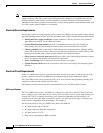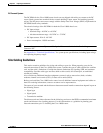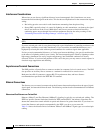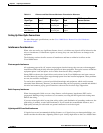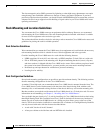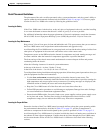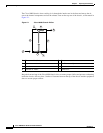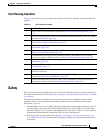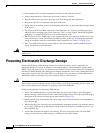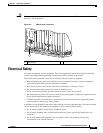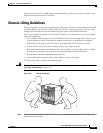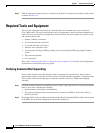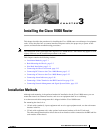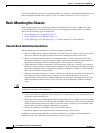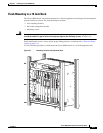
2-12
Cisco 10008 Router Hardware Installation Guide
OL-0659-13
Chapter 2 Preparing for Installation
Preventing Electrostatic Discharge Damage
• Never attempt to lift an object that might be too heavy to lift safely by yourself.
• Always unplug the power cable before you install or remove a chassis.
• Keep the chassis area clear and as dust free as possible during and after installation.
• Keep tools and chassis components away from walk areas.
• Do not wear loose clothing, jewelry (including rings and chains), or other items that could get caught
in the chassis.
• The AC-powered Cisco 10008 router ships with a three-wire AC electrical grounding-type plug,
which fits into a grounding-type power outlet only. This is a safety feature. Ensure the equipment
grounding is in compliance with local and national electrical codes.
• The DC-powered Cisco 10008 router is not shipped with wiring to connect to the DC source. You
must provide input, return, and earthing (grounding) wiring at the site, and install and protect the
wiring in accordance with local and national wiring regulations (see Table 3-2 on page 3-18).
• The Cisco 10008 router operates safely when it is used in accordance with its marked electrical
ratings and product usage instructions.
Warning
Only trained and qualified personnel should be allowed to install or replace this equipment
Statement 49
Preventing Electrostatic Discharge Damage
Electrostatic discharge (ESD) damage, which occurs when electronic cards or components are
improperly handled, can result in complete or intermittent failures. The performance routing engine
(PRE), and all line cards consist of a printed circuit card that is fixed in a metal carrier. Electromagnetic
interference (EMI) shielding and connectors are integral components of the carrier. Although the metal
carrier helps to protect the cards from ESD, use an antistatic strap each time you handle the modules.
Handle the carriers by the edges only; never touch the cards or connector pins.
Caution Always tighten the captive installation screws on all system components when you are installing them.
These screws prevent accidental removal of the module, provide proper grounding for the system, and
help to ensure that the bus connectors are properly seated in the backplane.
Following are guidelines for preventing ESD damage:
• Always use an ESD-preventive wrist or ankle strap and ensure that it makes good skin contact.
Before removing a card from the chassis, connect the equipment end of the strap to the ESD plug at
the bottom of the chassis below the power entry modules (Figure 2-2).
• Handle line cards by the faceplates and carrier edges only; avoid touching the card components or
any connector pins.
• When removing a line card, place the removed module component-side-up on an antistatic surface
or in a static-shielding bag. If the module will be returned to the factory, immediately place it in a
static-shielding bag.
• Avoid contact between the modules and clothing. The wrist strap protects the card from ESD
voltages on the body only; ESD voltages on clothing can still cause damage.



